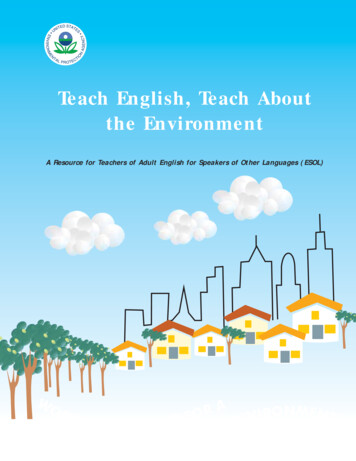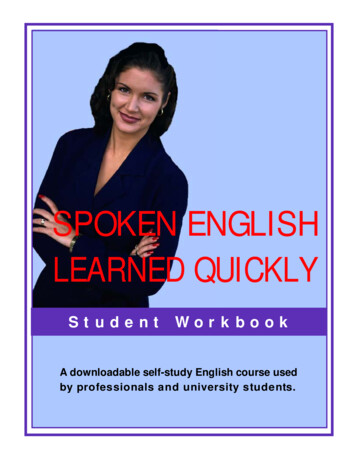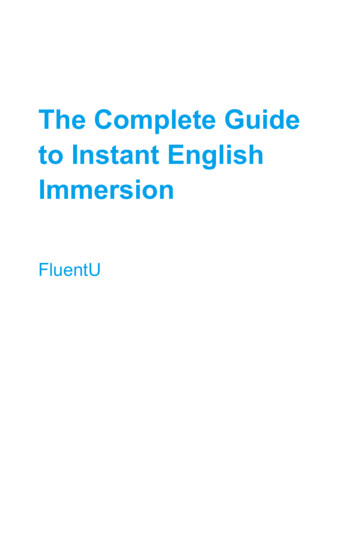
Transcription
Teach English, Teach Aboutthe EnvironmentA Resource for Teachers of Adult English for Speakers of Other Languages (ESOL)
Table of ContentsIntroduction. . . . . . . . . . . . . . . . . . . . . . . . . . . . . . . . . . . . . iNote to InstructorsLesson Plans. . . . . . . . . . . . . . . . . . . . . . . . . . . . . . ii. . . . . . . . . . . . . . . . . . . . . . . . . . . . . . . . . . . . . 1Beginning Level . . . . . . . . . . . . . . . . . . . . . . . . . . . . . . . . . . 3Intermediate Level . . . . . . . . . . . . . . . . . . . . . . . . . . . . . . 14Advanced Level . . . . . . . . . . . . . . . . . . . . . . . . . . . . . . . . . 25Appendices. . . . . . . . . . . . . . . . . . . . . . . . . . . . . . . . . . . . . 35Appendix 1: Training ESOL Teachers . . . . . . . . . . . . . . . . . . 37Preparing for Training . . . . . . . . . . . . . . . . . . . 38Conducting the Training Session . . . . . . . . . . . . 38Appendix 2: Using this Resource . . . . . . . . . . . . . . . . . . . . . 39Accessing United States EnvironmentalProtection Agency Resources . . . . . . . . . . . . . . . 39Background Information . . . . . . . . . . . . . . . . . . 40Appendix 3: Flash Facts . . . . . . . . . . . . . . . . . . . . . . . . . . . 43Appendix 4: Picture Files . . . . . . . . . . . . . . . . . . . . . . . . . 101
IntroductionAs a teacher of English for Speakers of Other Languages (ESOL), you know that yourclasses are extremely popular with immigrants and long-term visitors to the UnitedStates. These classes provide not only the opportunity to learn English but canserve as a portal through which many newcomers pass as a first step in integratingthemselves into their new communities and American society.The Environmental Protection Agency (EPA) has developed the Teach English, Teachabout the Environment curriculum to help you teach English to adult students whileintroducing basic concepts about the environment and individual environmentalresponsibility. These concepts can help the newly-arrived be part of cleaner andhealthier communities by understanding and practicing the “3Rs” of solid wastemanagement – reduce, reuse, recycle. “Background Information – The 3Rs of SolidWaste Management” on page 40 should be read before using this curriculum.The curriculum uses a hands-on, multi-sensory, multi-media approach to show howpersonal behavior can improve the overall environmental well-being of the family,home, and community. Lesson plans are provided for the beginner, intermediateand advanced student. Each lesson plan has a language as well as an environmentalobjective. It also provides background on the environmental objective, a list of materialsneeded, a glossary of terms used in that lesson and a worksheet. Lessons should beintroduced when the adult learner is already familiar with the grammatical constructionemphasized in the materials. Flash cards and picture files are also included.We hope that you find Teach English, Teach about the Environment a useful andinteresting resource for your students.i
Note to InstructorsThe Teach English, Teach About the Environment curriculum is a series of lessonsrelated to reducing, reusing and recycling waste. The lesson plans in the curricu lum should be introduced after the adult learner is already familiar with the gram matical constructions emphasized in the materials. The curriculum should be usedas a supplement to your traditional teaching materials.You should introduce and teach the vocabulary, as most students would probablybe unfamiliar with environmentally-related words.ii
Teach English, Teach About the EnvironmentA Resource for Teachers of Adult English for Speakers ofOther Languages (ESOL)Lesson PlansBeginning LevelIntermediate LevelAdvanced Level1
Beginning Level Lesson Plan 1Solid Waste Focus: RecycleEnvironmental ObjectiveIdentify common environmental values held in the United States related to recycling, reusingand reducing the waste stream.Materials NeededPictures a, b, c, d and eFlash Facts 1, 2, 3 and 7Newspapers, aluminum cans, glass bottles, plastic containers, boxes color-coded to match marked(glass, paper, plastic) receptacles for recycling.Background for the TeacherRecycling is an important way we can save energy and conserve natural resources. Manycommunities require residents to recycle and provide special color-coded receptacles for sortingand collecting the items to be recycled. Become familiar with your community’s procedures forrecycling. Determine if there are any penalties for failing to recycle.Language Objectives1.Simple present tense first person singular and pluralExamples: “I recycle glass.” “We recycle newspaper.”2.Adjective-noun orderExamples: glass bottle, aluminum canVocabularyaluminumplastic can (s)newspaper (s)recycleglassbottle (s)Procedures1.Post Flash Facts and pictures before class arrives. Arrange recyclable items on a table.2.Review related Flash Facts. Emphasize how recycling helps to conserve naturalresources.3.Examples: “I recycle newspaper.” “I recycle glass.” “I recycle plastic.” Place the itemsbeing recycled in the appropriate container. Use related picture files as your model.4.Take items out and have students say the same phrases as a group.5.Have groups of students say “I recycle ” depending on what type ofitem the teacher holds up.Teach English, Teach About the Environment3A Resource for Teachers of Adult English forSpeakers of Other Languages (ESOL)
Beginning Level Lesson Plan 16.Ask pairs of students to volunteer to say the correct phrase depending on what itemis being held up.7.See if individuals are willing to try the activity alone. Do not force them to talk ifthey do not want to.8.Repeat 2, 3, 4 and 5 using “we” instead of “I”.9.Provide students with Worksheet #1. Show one answer on the board.10.Assign Civic Integration Activity and Home Support Activity.11.Have students report back what they observed. Emphasize how the words they’velearned relate to values in the United States.Civic Integration Activity1.Ask students to observe whether their neighbors recycle their waste.2.Ask students to observe whether the school or their workplace recycles waste material.3.Ask at the following class what they observed.Home Support Activity1.Have students identify what items they could have recycled over a week’s time. Listitems. Discuss which natural resources would be conserved if the items were recycled.Relate to Worksheet #22.Have students weigh themselves on their bathroom scale at home. Then have themweigh themselves with the bag of household garbage thrown out each day. Multiply theweight difference by seven days, 30 days, and 365 days to get a sense of the amountof garbage generated by each student. Chart on board. Compare to Flash Fact #1.Teach English, Teach About the Environment4A Resource for Teachers of Adult English forSpeakers of Other Languages (ESOL)
Beginning Level Worksheet 1Name: Date:Fill in the missing letters.1.I newspaper.2.I recycle aluminum3.I recycle4.I5.6.W7.r y8.We9.We10.e.g .r newspaper.aluminum.n .c .s s .Teach English, Teach About the Environmentp .5A Resource for Teachers of Adult English forSpeakers of Other Languages (ESOL)
Beginning Level Lesson Plan 2Solid Waste Focus: RecycleEnvironmental ObjectiveIdentify common ways to recycle in our daily lives.Materials NeededPictures a, b, c, d, e, fFlash Facts 1, 3, 5 ,6, 7Additional Materials - Newspapers, aluminum cans, glass bottles, plastic containers, boxes colorcoded to match community receptacles for recycling.Background for the TeacherRecycling includes collecting, sorting and processing certain solid waste into raw materials forre-manufacture into new items. Look for a “c” on the bottom of plastic containers. It means thecontainer can be recycled. Many recyclable plastics can also be identified by the letters HDPE(milk jugs) and PET (soda bottles).When consumers purchase products manufactured from recycledmaterial they close the recycling loop.Language Objectives1. Review simple present tense first person singular and plural2. Introduce second person.Example: “You recycle newspaper.”3. Introduce third person singular.Examples:“He recycles .”“She recycles .”4. Introduce plural forms with he recycles ”.newspaper (s)recycleconserveTeach English, Teach About the Environment6natural resourcescan (s)bottle(s)A Resource for Teachers of Adult English forSpeakers of Other Languages (ESOL)
Beginning Level Lesson Plan 2Procedures1.Arrange recyclables and receptacle boxes on the table. Have several examples of eachrecyclable on the table.2.Review with class: “I recycle .” “We recycle .”3.Have class provide choral response.4.Repeat with “He recycles .” She recycles .”5.Reinforce plural “s” forms: “I recycle glass bottles.” “We recycle glass bottles.” Hold upexamples as the class repeats the activity. Repeat for all items.6.Form small circles of 6 to 10 students and model.7.“I recycle newspaper.” “You recycle newspaper.” Point to a person and accentuate“you”. Continue around the circle, passing the items as they speak.8.Change the items until every group has used newspaper, can(s), glass, and plastic.9.Discuss other ways to recycle in our daily lives.10.Identify the natural resources. Ask how recycling helps to conserve natural resources.11.Have students complete Worksheet #2.Civic Integration Activity1.Have students recycle items used or consumed during breaks. Example: cans, bottles,plastic or newspaper.2.Have them deposit recyclables in the containers as they come in from break.Home Support ActivityHave students create a recycling-related picture with a younger family member or friend. See“How My Family Recycles” at www.epa.gov/osw/kids/pdfs/jellyjar.pdf. Select a picture to color.Discuss the page selected.Teach English, Teach About the Environment7A Resource for Teachers of Adult English forSpeakers of Other Languages (ESOL)
Beginning Level Worksheet 2Name: Date:I, You, and WeA. CompletepgbnB. Complete1.I recycle newspapers.W bottles.Y bottles.2.I recycle glass.W .Y .Teach English, Teach About the Environment8A Resource for Teachers of Adult English forSpeakers of Other Languages (ESOL)
Beginning Level Lesson Plan 3Solid Waste Focus: ReuseEnvironmental ObjectiveIdentify reuse of common items normally thrown away.Materials NeededPictures a, b, c, d, g, hFlash Facts 1, 3, 5, 6, and 7Additional Materials - Plastic jug, aluminum can, glass bottleBackground for the TeacherThere are many creative ways to reuse items which might normally find their way into the wastestream: old shoe boxes can be used for storage, plastic containers for planters, etc. Students canalso donate or give away items rather than throwing these items into the waste stream. For alarge number of unwanted items, students can hold a garage sale. They can also be encouragedto shop at garage sales before buying new!Language Objectives1. Interrogatives with “How”2. Responses with “Can” for possibilityVocabularyaluminum can (s)plasticreusecontainer (s)producesource reductiongarbageproduct (s)wastenatural resourcesrecyclableProcedures1.Explain to the class that reuse of an item is a way to save our natural resources.2.Pair students or create small groups of three to discuss how to reuse each of the itemsin the picture from the Picture Files. Allow students three to five minutes per item tobrainstorm.3.Have students report to class by pairs or groups. Ask: “How can you reuse a glassbottle?”, “How can you use a plastic container?”a. I can reuse a glass bottle to/for .b. I/we can reuse plastic containers for/to .c. I/we can reuse plastic containers for/to .Teach English, Teach About the Environment9A Resource for Teachers of Adult English forSpeakers of Other Languages (ESOL)
Beginning Level Lesson Plan 34.List responses on board. Review how reuse of items reduces the waste stream,contributes to source reduction, and conserves resources.5.Have students complete Worksheet #3.6.Assign Civic Integration and Home Support Activities.7.Have students report back what they observed. Have students display their creativereuse of items.Civic Integration ActivityAsk students to observe ways local businesses or their neighbors may have reused items todecorate or for practical purposes; for example, turning used tires into planters.Home Support ActivityAsk students to reuse an item in a creative way. Have them bring the item(s) to class for display.Vote on the most creative, prettiest, etc. Give prizes or paper ribbons.Teach English, Teach About the Environment10A Resource for Teachers of Adult English forSpeakers of Other Languages (ESOL)
Beginning Level Worksheet 3Answer each question.1.How can you reuse the bottle?I can reuse it for a .2.How can we reuse the plastic jug?We can it for .3.How can they reuse the egg carton?They can reuse the for .4.How can we reuse the grocery bags?We can reuse them for .5.How can we reuse the boxes?for .Teach English, Teach About the Environment11A Resource for Teachers of Adult English forSpeakers of Other Languages (ESOL)
Beginning Level Lesson Plan 4Solid Waste Focus: ReduceEnvironmental ObjectiveIdentify easy ways to reduce the waste stream.Materials NeededPictures a, b, c, d, g, h, and iFlash Facts 1, 5, 6, 8, 9Background for the teacherThere are many other ways in which we can avoid adding to the waste stream. Some manufacturerspackage their products with oversized polystyrene foam. Students should be made aware of exces sive packaging and how to minimize it, if possible. One way to minimize packaging is to buy inbulk. Other ways to reduce waste include donating unwanted items to charities, holding a classswap meet to exchange unwanted items, and buying at garage sales.Language Objectives1.Interrogative words: How, Which3.Plural formsVocabularycharity (ies)swap meet (s)donatechurch (es)unwantedpackagingexchangewaste streamgarage sale (s)Procedures1.Review how reducing waste helps to reduce the waste stream. Have the studentsrepeat, “We buy in bulk.” “We donate old clothes.” “We swap items we don’t needfor items we do need.”2.Have the students to pair off and allow them to speak in their native language.Assign students to think of other ways to reduce the waste stream. Ask “How canwe reduce the waste stream?”3.Bring the class back together and have the pairs report their ideas.4.List their ideas on the board.5.Emphasize the value of donating unwanted items to churches or charities. Ask studentswhich local churches or charities might welcome donations.Teach English, Teach About the Environment12A Resource for Teachers of Adult English forSpeakers of Other Languages (ESOL)
Beginning Level Lesson Plan 46.Ask students if anyone ever gave a friend or family member something they nolonger used. Share the idea of a swap meet where students bring in items they nolonger want, and, in turn, swap or give the item to fellow classmates. Emphasizehow the leftover items could be donated to a church or charity.7.Using the students display the items collected and conduct an in-class swap meet.Donate any leftover items.8.Summarize ways to reduce the waste stream. Emphasize how reducing the wastestream conserves natural resources.Civic Integration ActivityUsing the churches or charities identified in Procedure 5, have the students collect items forthem. Donate the items.Home Support ActivityAssign students to collect unwanted but usable items to either swap in class or to donate to aspecified church or charity.Teach English, Teach About the Environment13A Resource for Teachers of Adult English forSpeakers of Other Languages (ESOL)
Intermediate Level Lesson Plan 1Solid Waste Focus:Recycling, Reusing, ReducingEnvironmental ObjectiveCompare and contrast environmental values held in the United States related to recycling,reusing, and reducing to those held in countries represented by students in the adult ESOL class.Materials NeededPictures k, a, b, c, d, e, f, iFlash Facts 6, 10, 11, 12, 15, 16, 17Photos of trees, recycling receptacles, excessive packaging, glass, cans, etc.Background for the TeacherRecycling saves natural resources. It also saves energy and reduces human impacts on the climate.Paper and aluminum are recycled with great success. Successful recycling, reducing and reusingmeans less depletion of dwindling natural resources. International values related to recycling,reusing and reducing may vary. Compare and contrast your students’ values related to recycling,reusing, and reducing.Language Objectives1.Questions with auxiliary verb “Did”2.Interrogative words “What,” “Why,” “How”3.Simple past tense responsesVocabularycontainer (s)reusableforest (s)excessiveshopping bag (s)waste streampackagingpaper mill (s)item (s)Teach English, Teach About the Environment14A Resource for Teachers of Adult English forSpeakers of Other Languages (ESOL)
Intermediate Level Lesson Plan 1Procedures1.Post pictures and flash facts before class arrives.2.Discuss the beauty of the natural environment reflected in the picture of the trees.Ask if forests exist in their countries. “Did you have forests in your country?” Chartresponses by country.a. Did you recycle paper in your country?b. Did you recycle other products?3.Ask: Did you reuse items in your homeland?Have students pair off and discuss how they reused items in their homelands. Givethem five minutes to discuss, and then share responses. Chart answers by country,listing what items were reused and how they were reused.4.Discuss pictures showing excessive packaging. Was so much packaging really needed?Why do manufacturers like excessive packaging? Have students compare andcontrast ways they could reduce excessive use of packaging. Examples might includeselecting products with less packaging, using reusable shopping bags, and writingthe manufacturers.5.Wrap up by reviewing the class chart. Emphasize the importance of conserving naturalresources by reducing, reusing and recycling waste.Civic Integration ActivityHave students hold an in-class “unwanted items” meet to exchange or sell items they do notneed or use. Explain how exchanging is a form of recycling.Home Support Activity1.Have students interview families about solid waste disposal in their homelands. Useattached interview sheet.2.Have students collect and bring in examples of the ways they reuse items they mighthave ordinarily discarded. Display reused items. Select the most creative, most original,and most unusual and give prizes for each.Teach English, Teach About the Environment15A Resource for Teachers of Adult English forSpeakers of Other Languages (ESOL)
Intermediate Level Support ActivityName: Date:1.How was solid waste handled in your homeland? Was it collected, and taken to alandfill? Burned? Who took care of these activities?2.What were people’s attitudes toward waste?3.Were people concerned about conserving natural resources?4.Other comments.Teach English, Teach About the Environment16A Resource for Teachers of Adult English forSpeakers of Other Languages (ESOL)
Intermediate Level Lesson Plan 2Solid Waste Focus: RecycleEnvironmental ObjectiveCompare and contrast ways people recycle in each of the students’ countries to recycling in theUnited States.Materials NeededPictures (a) through (f)Flash Facts 1, 2, 3, 10, 12, 13, 14, 15, 16, 17 and 18Background for the TeacherMany communities conduct curbside recycling. After the recyclables are collected, they are trans ported to a collection center where they are sorted and sent to facilities that can process theminto new materials or products. Buying recycled closes the recycling loop.Language Objectives1.Simple past tense with an emphasis on pronunciation of the final syllable2.Interrogative words: What, How, Why, Which3.Plural with “s” with an emphasis on pronunciation of plural soundsVocabularyaluminumpenalty (ies)jar (s)collectionpapercontainer (s)glassfine (s)newspaper(s)plastic (s)magazines (s)Procedures1.Post Pictures and Flash Facts before class arrives.2.Using the Picture Files, discuss recycling in the United States. Refer to the symbol forrecycling on containers and the types of items which are recycled. Review the benefitsof recycling by referring to the Flash Facts which have been posted. Elicit additionalexamples of recycling from the students’ experiences in the community. Stress theimportance of purchasing items made from recycled material.3.Pair or group students by home countries. Allow them five to seven minutes to discussrecycling as practiced in their home countries and have them list examples. Have pairs/groups share recycling practices from their home countries and chart on the board.Have pairs respond to “What did you recycle and why?” Be sure they pronounce anyplural sounds used.Teach English, Teach About the Environment17A Resource for Teachers of Adult English forSpeakers of Other Languages (ESOL)
Intermediate Level Lesson Plan 24.When all groups/pairs have reported, ask which items they recycle in theUnited States.5.Compare and contrast recycling practices.6.Assign Civic Integration and Home Support activities.Civic Integration ActivityHave students determine whether their communities require residents to recycle. Access thecommunity website on the Internet or call City Hall. Ask local businesses (photocopy center,service station, etc.) if they recycle.Home Support ActivityHave students create a poster with their families describing why they should recycle. Displayposters. Have students describe their posters. If students wish to be more creative, they cancreate a collage from recyclables.Teach English, Teach About the Environment18A Resource for Teachers of Adult English forSpeakers of Other Languages (ESOL)
Intermediate Level Lesson Plan 3Solid Waste Focus: ReuseEnvironmental ObjectiveCompare and contrast ways people reuse items both in the United States and in the students’native countries.Materials NeededPictures a, b, c, d, g, and hFlash Facts 2, 5, 9, 14, 17, 18Background for the TeacherThroughout the world, people have been very resourceful in reusing items. Your students maycontribute very creative and clever ways containers are recycled for other uses, including children’sgames, planters, etc. Reusing items helps save energy and conserves natural resources.Language Objectives1.Interrogative words with simple past tenseExamples: “How did?” “Why did?” “What did?”2.Simple past responsesExamples: “I reused.” “We reused.”3.Plural with “s” with an emphasis on pronunciation of plural soundsVocabularycharity (ies)reusablegarage sale (s)donaterecycled contentproduct (s)Procedures1.Post Pictures and Flash Facts before class arrives.2.Remind students how recycling and reusing items made of glass, aluminum or plastichelps to conserve our natural resources. Use Pictures Files a, b, c, and d to illustrateyour point. Incorporate the Flash Facts into your discussion of reducing the wastestream. Relate these facts to conserving resources.3.Pair/group students to discuss ways people reused glass, aluminum or plastic items intheir native lands. Allow them to share for five to seven minutes. Elicit responses to“My neighbor reused .”Teach English, Teach About the Environment19A Resource for Teachers of Adult English forSpeakers of Other Languages (ESOL)
Intermediate Level Lesson Plan 34.Bring the group back together and share ways containers and items were reused. Elicitresponses to “We reused for .”5.Using Picture Files or real objects prompt the students to answer the following ques tions. Make sure they correctly pronounce the --ed endings of the verb in theirresponses.a. What did we recycle?We recycled .b. What did they sort?They sorted .c. What did you rinse?I rinsed .d. What did I reuse?You reused .e. What did we collect?We collected .f. What did you reduce?I reduced .6.Ask if people held garage sales in their homelands. Ask how these helped to conserveresources.7.Assign Worksheet # 1.8.Assign Civic Integration and Home Support Activities.Civic Integration Activity1.Have students observe ways people in their neighborhoods or communities havereused items. Ask them to share what they observed.2.Have students stop at a garage sale and report what was being sold.Home Support Activity1.Have students use common containers (empty jelly jars) and create new uses forthem. Have them bring the items in for a class display.2.Ask them to demonstrate children’s games played with reused containers or items.3.Download “Follow That Trail” from EPA’s web site. Read and discuss page 5 with theyoungsters in their families.Teach English, Teach About the Environment20A Resource for Teachers of Adult English forSpeakers of Other Languages (ESOL)
Intermediate LevelWorksheet 1Name: Date:Complete the sentences1.What did you reuse?I reused .2.What did you collect?I collected .3.What did they collect?They collected .4.What did you rinse?I rinsed .5.What did they sort?They sorted .6.Summarize ways we can reuse items. Have classcontribute to the summary.Teach English, Teach About the Environment21A Resource for Teachers of Adult English forSpeakers of Other Languages (ESOL)
Intermediate Level Lesson Plan 4Solid Waste Focus: ReduceEnvironmental ObjectiveCompare and contrast ways to reduce the solid waste stream in our daily lives.Materials NeededPictures g, h, iFlash Facts 1, 8, 9, 14, 18, 19Background for the TeacherReducing the waste stream can begin with reducing excessive packaging, donating items, or sell ing items at a garage sale. Reducing the waste stream also occurs when we substitute cloth itemsfor paper towels, napkins, bags, and disposable diapers. Reducing the waste stream by changingthrow-away habits helps conserve our natural resources.Language Objectives1.Practice perfect tense verbs in the interrogative as well as responses2.Paragraph sable containersexcessive packagingthrow-away habitsgarage sale (s)waste streamProcedures1.Review with class ways we can reuse and recycle items.2.Challenge pairs or small groups of students to think of additional ways we can con tribute to reducing the waste stream. Let groups brainstorm for seven to ten minutes.3.Bring group back together and discuss their ideas for reducing waste. Chart responses.4.Be sure the class considers other options. “Have you ever donated items to a charity?”“Have you ever held or shopped at a garage sale?”5.Ask students if they noticed examples of excessive packaging in the products they buy.“Why have the manufacturers tried to enhance their products with excessive packaging?”6.Emphasize the positive effects of buying in bulk to minimize packaging and thereforereduce waste. Ask why people do not buy in bulk?7.Summarize the ways the class has determined we can reduce the waste stream. Havestudents contribute to the summary.Teach English, Teach About the Environment22A Resource for Teachers of Adult English forSpeakers of Other Languages (ESOL)
Intermediate Level Lesson Plan 4Civic Integration Activity1.Coordinate a class garage sale either at school or at someone’s home.Donate any funds and unsold items to a local charity.Emphasize how reducing the waste stream helps conserve natural resources.2.Explore on the Internet ways to reduce the waste stream.Visit www.epa.gov/ows/. Use local libraries to access the Internet, if students do nothave a computer at home.Home Support Activity1.Have students collect items to contribute to a class garage/tag sale. Explain thatunsold items will be donated. Explain how reuse of an item reduces the waste stream;invite friends and family to participate.Teach English, Teach About the Environment23A Resource for Teachers of Adult English forSpeakers of Other Languages (ESOL)
Intermediate Level Lesson Plan 4Holding a Tag Sale/ Garage SaleChecklist Chose a location: school, community center, church yard. Make sure it’saccessible by public transportation and/or has parking. Determine date and time for garage sale. Make sure the day and timedon’t conflict with other planned events. Make signs announcing the sale and post them around the school, com munity center or neighborhood. You might also want to advertise in thelocal newspaper. Ask students to collect items they no longer need or use. Make sure theitems are clean and in working condition. Set up collection boxes for the items. Assign at least twopeople to be in chargeof the money. Have at least 20 inchange. After the sale, donateunsold items to a localcharity chosen by theclass. Donate sale funds tothe charity or usethe money for classactivities.Price the items reasonably. Be willing to negotiate the day of the sale.Have students gather and bring in extra grocery and shopping bags to useat the event.Teach English, Teach About the Environment24A Resource for Teachers of Adult English forSpeakers of Other Languages (ESOL)
Advanced
Teach English, Teach about the Environment . curriculum to help you teach English to adult students while introducing basic concepts about the environment and individual environmental responsibility. These concepts can help the newly-arrived be part of cleaner and healthier communities










